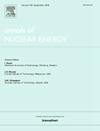Experimental and CFD simulation of a printed circuit heat exchanger design
IF 1.9
3区 工程技术
Q1 NUCLEAR SCIENCE & TECHNOLOGY
引用次数: 0
Abstract
A 4×4 mm straight square channel printed circuit heat exchanger is designed and manufactured for applications in nuclear facilities. Thermal and hydraulic characteristics of the heat exchanger are evaluated on a test rig using water as the coolant on both sides over a mass flux range from 62.5 kg/m2s to 562.5 kg/m2s. The pressure loss is measured across the hot and cold channels. The friction factor of the hot side is 4 times and the cold side is 3 times higher compared to the straight circular pipe. A friction factor correlation based on experimental data is developed for both sides of the channel. Heat transfer experiments are conducted with the hot inlet temperature varied from 331.15 K to 349.15 K. The heat transfer rate rises with an increase in hot inlet temperature and mass flux. The heat transfer rate increases linearly with the mass flux for a fixed hot inlet temperature. The heat transfer rate also depends on the hot inlet temperature. A 1.9 % and 4.6 % increase in the hot inlet temperature results in a 28 % and 72.2 % increase in the heat transfer rate, respectively, for a mass flux of 281.25 kg/m2s on the hot side and 562.5 kg/m2s on the cold side. Computational fluid dynamics simulations are performed for the printed circuit heat exchanger. The simulations are validated through experimental data. The simulation results are used to study the heat transfer characteristics of the heat exchanger. For the maximum mass flux and hot inlet temperature, the hot and cold sides exhibit a Nusselt number of 26.6 and 28.8, respectively. Correlations for the hot and cold side Nusselt number for the square channel are also developed. The friction factor and the Nusselt number are used to evaluate the Performance Evaluation Criteria. For the maximum operating conditions of the study, a Performance Evaluation Criteria of 8.5 is achieved on both the hot and cold sides, respectively. The heat exchanger design is highly compact and efficient in heat transfer, making it suitable for reducing the size and enhancing the efficiency of small modular reactors.
印刷电路换热器设计的实验与CFD模拟
一种4×4毫米直方通道印刷电路热交换器设计和制造应用于核设施。热交换器的热学和水力特性在一个试验台上进行了评估,在质量通量范围为62.5 kg/m2s至562.5 kg/m2s之间,两侧使用水作为冷却剂。通过热通道和冷通道测量压力损失。热侧摩擦系数是直圆管的4倍,冷侧摩擦系数是直圆管的3倍。在实验数据的基础上,建立了通道两侧摩擦系数的相关关系。热进口温度在331.15 ~ 349.15 K范围内进行换热实验。传热速率随热入口温度和质量通量的增大而增大。对于固定的热入口温度,传热速率随质量通量线性增加。传热速率也取决于热入口温度。在热侧质量通量为281.25 kg/m2s和冷侧质量通量为562.5 kg/m2s的情况下,热进口温度分别提高1.9%和4.6%,传热率分别提高28%和72.2%。对印刷电路换热器进行了计算流体动力学仿真。通过实验数据对仿真结果进行了验证。利用模拟结果对换热器的传热特性进行了研究。对于最大质量通量和热入口温度,热侧和冷侧的努塞尔数分别为26.6和28.8。对方形通道的冷热侧努塞尔数也进行了相关分析。使用摩擦系数和努塞尔数来评价性能评价标准。对于研究的最大运行条件,冷热侧的性能评价标准分别达到8.5。换热器设计紧凑,传热效率高,适用于小型模块化反应器的体积缩小和效率提高。
本文章由计算机程序翻译,如有差异,请以英文原文为准。
求助全文
约1分钟内获得全文
求助全文
来源期刊

Annals of Nuclear Energy
工程技术-核科学技术
CiteScore
4.30
自引率
21.10%
发文量
632
审稿时长
7.3 months
期刊介绍:
Annals of Nuclear Energy provides an international medium for the communication of original research, ideas and developments in all areas of the field of nuclear energy science and technology. Its scope embraces nuclear fuel reserves, fuel cycles and cost, materials, processing, system and component technology (fission only), design and optimization, direct conversion of nuclear energy sources, environmental control, reactor physics, heat transfer and fluid dynamics, structural analysis, fuel management, future developments, nuclear fuel and safety, nuclear aerosol, neutron physics, computer technology (both software and hardware), risk assessment, radioactive waste disposal and reactor thermal hydraulics. Papers submitted to Annals need to demonstrate a clear link to nuclear power generation/nuclear engineering. Papers which deal with pure nuclear physics, pure health physics, imaging, or attenuation and shielding properties of concretes and various geological materials are not within the scope of the journal. Also, papers that deal with policy or economics are not within the scope of the journal.
 求助内容:
求助内容: 应助结果提醒方式:
应助结果提醒方式:


